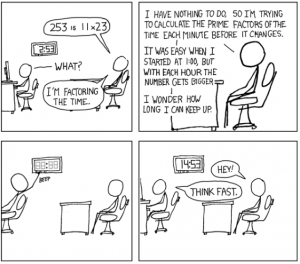Factor Clock
The factor clock displays the time in the form ![]() , that is, as
, that is, as ![]() , and then decomposes the number
, and then decomposes the number ![]() into prime factors. For example, a quarter of an hour past eleven, that is, at 11:15:00, the following is displayed:
into prime factors. For example, a quarter of an hour past eleven, that is, at 11:15:00, the following is displayed: ![]() . The somewhat strange idea of reading the time (including seconds) as a decimal number and then factorizing it goes back to the Internet comic series xkcd, see Figure 1 below:
. The somewhat strange idea of reading the time (including seconds) as a decimal number and then factorizing it goes back to the Internet comic series xkcd, see Figure 1 below:


